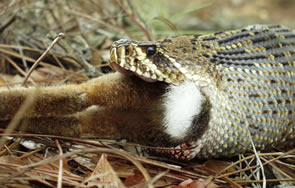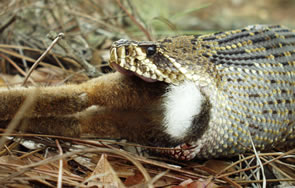The Eastern Diamondback Rattlesnake, also known as Crotalus adamanteus, is one of the largest venomous snakes in North America. These snakes are found throughout the southeastern United States and are known for their distinctive diamond-shaped patterns on their backs and their intimidating rattles.
One of the most interesting aspects of these snakes is their diet. Eastern Diamondback Rattlesnakes are known to eat a variety of prey, including small mammals, birds, and even other snakes. In this article, we will explore the fascinating world of what these snakes eat and how they hunt their prey.
Eastern Diamondback Rattlesnakes are carnivorous and primarily eat rodents such as rats and mice. They also consume other small mammals such as rabbits, birds, and even other snakes. These rattlesnakes are opportunistic hunters and will eat any prey they can overpower.

What do Eastern Diamondback Rattlesnakes Eat?
Eastern Diamondback Rattlesnakes, also known as Crotalus adamanteus, are one of the largest venomous snakes found in North America. These snakes are commonly found in the southeastern United States and are known for their distinctive diamond-shaped pattern on their backs. Eastern Diamondback Rattlesnakes are carnivores and feed on a variety of prey. In this article, we will discuss what Eastern Diamondback Rattlesnakes eat.
Small Rodents
Eastern Diamondback Rattlesnakes primarily feed on small rodents such as mice, rats, and squirrels. These snakes are skilled hunters and use their heat-sensing pits to locate prey. Once they have located their prey, they strike with lightning-fast speed and inject venom into their prey. The venom of the Eastern Diamondback Rattlesnake is highly toxic and can kill their prey within minutes.
Eastern Diamondback Rattlesnakes are opportunistic feeders and will eat whatever prey is available. They have been known to eat other snakes, lizards, and birds as well. However, their primary food source is small rodents.
Large Mammals
Eastern Diamondback Rattlesnakes are capable of eating large mammals such as rabbits, opossums, and even deer. However, it is not common for these snakes to prey on larger animals. Eastern Diamondback Rattlesnakes typically prefer to feed on smaller prey that is easier to catch and consume.
When feeding on larger prey, Eastern Diamondback Rattlesnakes will use their powerful jaws to latch onto their prey and inject venom. They will then wait for their prey to die before consuming it. Feeding on larger prey can take several days, and Eastern Diamondback Rattlesnakes may not need to eat again for several weeks after consuming a large meal.
Fish and Amphibians
Eastern Diamondback Rattlesnakes are also known to feed on fish and amphibians. These snakes are excellent swimmers and can catch fish in the water. They will also consume frogs, toads, and other amphibians that live near the water.
When feeding on fish, Eastern Diamondback Rattlesnakes will use their powerful jaws to latch onto their prey and consume them whole. They will also consume the bones and other parts of the fish that are not digestible.
Insects
While Eastern Diamondback Rattlesnakes primarily feed on small rodents and other larger prey, they have been known to consume insects as well. These snakes have been observed eating insects such as grasshoppers and beetles.
When feeding on insects, Eastern Diamondback Rattlesnakes will use their jaws to crush the exoskeleton of the insect before consuming it. However, insects make up a very small part of their diet.
Birds
Eastern Diamondback Rattlesnakes have been known to feed on birds as well. These snakes will prey on birds that are nesting on the ground or low in trees. Once they have located their prey, they will strike and inject venom, killing the bird almost instantly.
When feeding on birds, Eastern Diamondback Rattlesnakes will consume the entire bird, including the feathers and bones. However, birds make up a very small part of their diet.
Benefits of Eastern Diamondback Rattlesnakes
Eastern Diamondback Rattlesnakes play an important role in the ecosystem. They help control the population of small rodents, which can cause damage to crops and other vegetation. These snakes also help control the population of other snakes and lizards.
The venom of the Eastern Diamondback Rattlesnake is also being studied for its potential medical benefits. Researchers are looking into the use of Eastern Diamondback Rattlesnake venom for the treatment of cancer and other diseases.
Eastern Diamondback Rattlesnakes vs. Other Snakes
Eastern Diamondback Rattlesnakes are often compared to other venomous snakes such as the Copperhead and Water Moccasin. While these snakes are similar in some ways, there are some key differences.
Eastern Diamondback Rattlesnakes are much larger than Copperheads and Water Moccasins. They also have a more potent venom, which can cause more severe symptoms in humans. However, Eastern Diamondback Rattlesnakes are less aggressive than Copperheads and Water Moccasins and will often try to avoid confrontation.
Conclusion
In conclusion, Eastern Diamondback Rattlesnakes are carnivores and primarily feed on small rodents such as mice and rats. They are also known to eat other animals such as fish, amphibians, and birds. These snakes play an important role in the ecosystem and their venom is being studied for its potential medical benefits. While Eastern Diamondback Rattlesnakes are often compared to other venomous snakes, they have their own unique characteristics that make them one of the most fascinating creatures in the animal kingdom.
Frequently Asked Questions
Eastern Diamondback Rattlesnakes are fascinating creatures that live in the southeastern region of the United States. They are known for their impressive size and venomous bite. One of the most common questions people have about them is what they eat. Here are five questions and answers to help you learn more about what Eastern Diamondback Rattlesnakes eat.
What is the diet of an Eastern Diamondback Rattlesnake?
Eastern Diamondback Rattlesnakes are carnivorous and primarily eat small mammals like rodents, rabbits, and squirrels. They have been known to eat birds and reptiles as well.
Eastern Diamondback Rattlesnakes are ambush predators and will often wait for their prey to come to them. They use their heat-sensing pits to detect prey and then strike with their venomous bite.
How much do Eastern Diamondback Rattlesnakes eat?
Eastern Diamondback Rattlesnakes can eat up to a quarter of their body weight in one meal. They have a flexible jaw that allows them to swallow prey whole, which they then digest over the course of several days or weeks.
Eastern Diamondback Rattlesnakes can go weeks or even months without eating, but they will eat whenever prey is available.
Do Eastern Diamondback Rattlesnakes eat other snakes?
Yes, Eastern Diamondback Rattlesnakes will eat other snakes, including other venomous species. They are also known to cannibalize other Eastern Diamondback Rattlesnakes.
However, Eastern Diamondback Rattlesnakes do not exclusively eat snakes. They have a varied diet and will consume whatever prey is available to them.
How do Eastern Diamondback Rattlesnakes hunt?
Eastern Diamondback Rattlesnakes are ambush predators and will often wait for their prey to come to them. They use their heat-sensing pits to detect prey and then strike with their venomous bite. They have a unique warning system in the form of their rattle, which they use to deter predators and warn humans of their presence.
Eastern Diamondback Rattlesnakes are also excellent swimmers and will hunt in and around bodies of water.
What happens if an Eastern Diamondback Rattlesnake can’t find food?
Eastern Diamondback Rattlesnakes can go weeks or even months without eating, but they will eat whenever prey is available. If they can’t find food, they will conserve energy by reducing their activity level and metabolism.
During periods of food scarcity, Eastern Diamondback Rattlesnakes may also seek out cooler, more sheltered areas to conserve energy and avoid dehydration.
Big Bad Eastern Diamondback Rattlesnake’s First Feeding (MUST SEE!!!)
In conclusion, Eastern Diamondback Rattlesnakes are fascinating creatures that play a crucial role in maintaining ecological balance in their habitat. Their diet consists of a variety of prey, including rodents, birds, lizards, and other snakes. However, their preference for rodents makes them valuable allies in controlling rodent populations, which can cause significant damage to crops and other plants.
It is essential to understand the dietary habits of these snakes to ensure their survival and to prevent any negative impact on their ecosystem. As with any wild animal, it is crucial to respect their space and avoid contact with them. If you ever encounter an Eastern Diamondback Rattlesnake, it is best to observe it from a distance and give it the space it needs to thrive.
In conclusion, Eastern Diamondback Rattlesnakes are an integral part of the food chain and play an essential role in maintaining the balance of their ecosystem. By staying informed about their dietary habits and respecting their space, we can coexist with these magnificent creatures and appreciate their unique contribution to the natural world.


